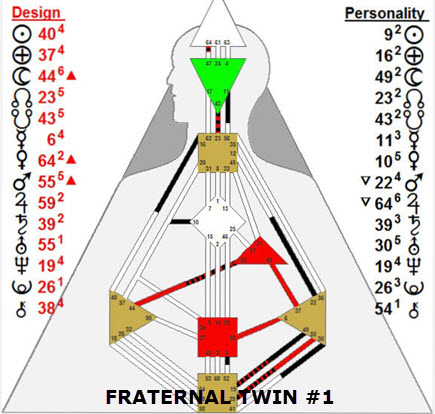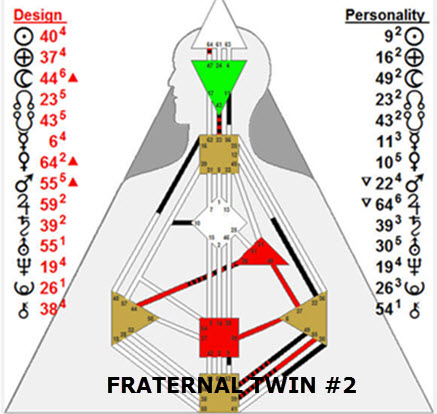In Part I (HUMAN DESIGN: SAME CHART, DIFFERENT SOULS, PART I), I shared my working reflections on how the same human design can manifest so differently in two individuals. I examined the various aspects that different souls bring to their human design, including their soul trajectory, unique dharmas, karmas, and life purpose.
Building on these reflections, in this conversation, I consider how different expressions can stem from the same definition.
Part II: Different expressions can emerge from the same basis
How does the same definition give rise to different expressions?
The Artisan Soul Archetype
Fraternal Twin #1 is extroverted, strong-willed, and argumentative. He takes a stand for his convictions and feelings, not always diplomatically, and sometimes in an offensive manner. He is creative and understands the mechanics of structure—how things are put together. He is interested in creating beautiful objects, both for their aesthetic appeal and functionality, and expresses himself through artistic and engineering pursuits. In his case, the drive for creativity and innovation directly impacts how his human design chart is expressed. Career-wise, he may be drawn to roles such as artist, inventor, writer, or athlete, where creativity and structure are central.
The Scholar Soul Archetype
Fraternal Twin #2 is introverted, avoids arguments, is studious, and keeps his feelings and opinions to himself. He is naturally inclined to seek knowledge and sees life as an experiment or classroom, constantly gathering and sifting information. This focus informs his self-expression in relation to his human design chart. Career-wise, he might be drawn to paths such as science, research, writing, mathematics, or academia, reflecting his inclination to study and observe.
By introducing the archetypes of Artisan and Scholar (among others), I aim to provide more food for thought on why the same chart can convey different meanings. Yet, our primary focus remains on utilizing our understanding of the human design chart as the basis for why Fraternal Twin #1 and Fraternal Twin #2 are so different.
With that in mind, remember that both Fraternal Twin #2 and Fraternal Twin #1 are very young. At age 12, they are children at the precipice of their lives and have many more experiences to incorporate, digest, and form beliefs and self-knowledge from. Therefore, who they will show up as later in life is far from solidified. In the meantime, we have a few evolving personality details and a permanent design to focus on.
Both fraternal twins, Fraternal Twin #1 and Fraternal Twin #2, demonstrate sensitivity and responsiveness to their environment. The 19-49 and the 39-55 Channels indicate high levels of sensitivity, creativity, and moodiness. Fraternal Twin #1 expresses his sensitivity defensively, and Fraternal Twin #2 expresses it by avoiding conflict. Fraternal Twin #2 also cries when conflict arises, again indicating his sensitivity to becoming easily imbalanced by external events in his environment. They have the 43-23, a channel known for its individuality, melancholy, genius, and sense of being an outsider. The 43-23 often finds it difficult to articulate their vision in a way that will be understood, and even better, supported by their community.
Variable Influence of the Centers
The open Head Center creates pressure to come up with answers to others’ questions, and to live out others’ ideas or inspirations. This can create confusion, especially in someone so young, about what they truly consider inspirational and what questions they are personally interested in getting answered.
Their open Identity Center leads to a fluid sense of self. They naturally adapt and may unconsciously take on others’ identities. It will take time for each to connect to a firm understanding of themselves. The open G-Center’s adaptive nature can cause outbursts (Fraternal Twin #1) or withdrawal (Fraternal Twin #2) as they struggle to establish their identity. At times, they may not recognize themselves, having drifted from a comfortable self-expression. At their age, trying out personalities is natural. Fraternal Twin #2 will likely research his interests and gradually understand himself. Fraternal Twin #1 will learn through his creations and how others respond to them.
Not much is noted in the information provided regarding how the 44-26 is being expressed, but what we know about these boys hints at, particularly in Fraternal Twin #1, the drive to take ideas and give them physical form.
The defined Will Center shows in Fraternal Twin #1 as defiance, tied to being right or proving himself, perhaps masking insecurity. Fraternal Twin #2 seems to express the not-self side—being more reserved about his value, possibly due to uncertainty. Fraternal Twin #1’s interest in creating material things also suggests business talent.
The Impact of Emotional Authority
The twins have complex emotional authority. They have two distinct wave types, tribal and individual. The individual wave needs time to experience the length of its entire wave at least once before it can arrive at sufficient clarity. The tribal wave is not as long or as intense, except in cases involving personal and family connections. The emotional wave is melancholic, which can come off as anger and withdrawal. Its penetrating emotional depth can be confusing and overwhelming, even for adults. It takes observation to learn that you cannot resist this wave, and to understand how it operates in you. It is necessary to surrender to its highs and lows before you achieve clarity on how you feel about something and what you really want to do. This long, individual wave is designed to make life-changing decisions by taking its time before committing. Forcing the “hand” of the 39-55 can have negative consequences. Each individual will have their own way of expressing this wave, and none will be wrong, but their duration and cycle can be very different.
Elements of the Chart
Each twin is working on self-empowerment and self-love (Gate 10) in their own way. Each expresses ideas (Gate 11) in their own way, and each brings inspirational downloads (Gate 64) that they will apply to their insights and creations in their own unique way.
In gate 44, we can see the patterns that aren’t working and how to transform them so that our patterns can be aligned with our purpose. Our awareness of what’s possible shifts when we break free from the old patterns or paradigms that have kept us stuck in our thinking. Gate 44 also inspires us to create beautiful environments. Each twin will be drawn to creating a venue that others will benefit from.
Their conscious Sun (Gate 9) is the gate of focus. Gate 9 has the potential for obsessive behavior and thinking. We see this in Fraternal Twin #1, and perhaps in Fraternal Twin #2 as well, although not much has been said about his need to develop an intense relationship to his passion, other than what might be hinted at via his tendency to be studious.
Their Profile, 2/4, the Hermit Opportunist, expresses as both shy (2) and social (4). Hermit Opportunists bond through a strategy of both shyness and boldness. We observe the shyness expressed more overtly in Fraternal Twin #2 (and perhaps solely at this time), while Fraternal Twin #1 exhibits boldness, with less apparent emphasis on being shy and withdrawn (2). Both of these boys are currently being called upon (and will continue to be called upon) to share their talents, and they will depend on their network of close friends and associates for mentoring and opportunities.
Insufficient information is available to comment on how they express their Incarnation Cross, the Right Angle Cross of Planning.
This concludes Part II.
In Part III (HUMAN DESIGN: SAME CHART, DIFFERENT SOULS, PART III), we will look at how soul or life purpose is identified in the twins’ design charts.
© 2015 | Gloria Constantin | All Rights Reserved |
Need help or have questions? Contact Me

